Navigating the complexities of trading with Elliott Wave Theory requires a meticulous approach and a keen eye for market patterns. By mastering the art of identifying impulse waves and corrective waves, traders can gain a deeper insight into market dynamics.
However, the challenge lies in effectively applying these principles to real-time trading scenarios. Understanding the nuances of Fibonacci ratios, staying patient during analysis, and adapting to evolving market conditions are just a few of the essential strategies that can significantly impact trading success.
But how can traders effectively implement these tips to enhance their trading performance?
Understanding Wave Patterns
In the realm of technical analysis, a crucial aspect that traders delve into is comprehending wave patterns within the framework of Elliott Wave Theory. Wave patterns play a fundamental role in understanding market dynamics, offering insights into potential trade opportunities and trend changes.
Elliott Wave Theory differentiates between impulse waves and corrective waves based on price movements. Impulse waves propel in the direction of the prevailing trend, indicating strong buying or selling pressure. On the other hand, corrective waves act as temporary price reversals or consolidations within the larger trend, providing traders with entry points to position themselves for the next impulse wave.
Recognizing when corrective waves mimic impulse waves is crucial as it can signify an impending shift in the trend direction. By closely analyzing wave patterns, traders can enhance their ability to anticipate market movements, optimize entry and exit points, and capitalize on evolving trends effectively.
Identifying Reversal Points
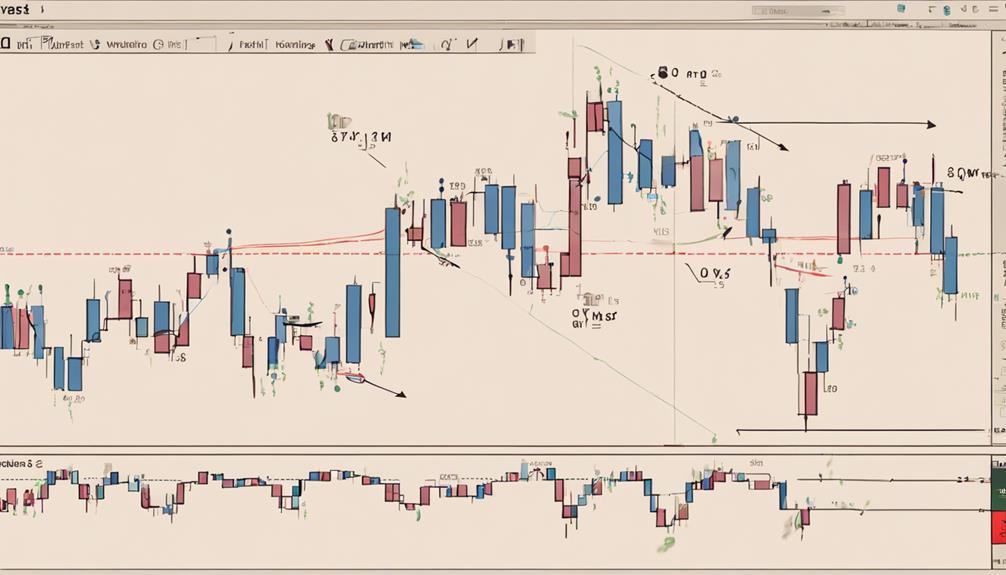
Are there discernible signs that can assist traders in pinpointing potential reversal points within the framework of Elliott Wave Theory? Reversal points play a crucial role in trading, indicating where the market direction is likely to change. To identify these key levels effectively, traders can utilize various techniques and indicators:
- Fibonacci Retracement: These levels often coincide with potential reversal points, providing traders with areas of interest to watch for price action signals.
- Reversal Patterns: Patterns like double tops/bottoms or head and shoulders can signal potential turning points in the market, offering valuable insights for traders.
- Volume Analysis: Analyzing trading volume can confirm reversal points by showing increased buying or selling pressure at specific levels.
- Moving Averages: These can act as dynamic support or resistance levels at potential reversal points, aiding traders in gauging the strength of a potential reversal.
- Wave Structure: Understanding the wave structure within Elliott Wave Theory can also help in identifying potential reversal points as specific wave counts can indicate the end of a trend.
Applying Fibonacci Retracement
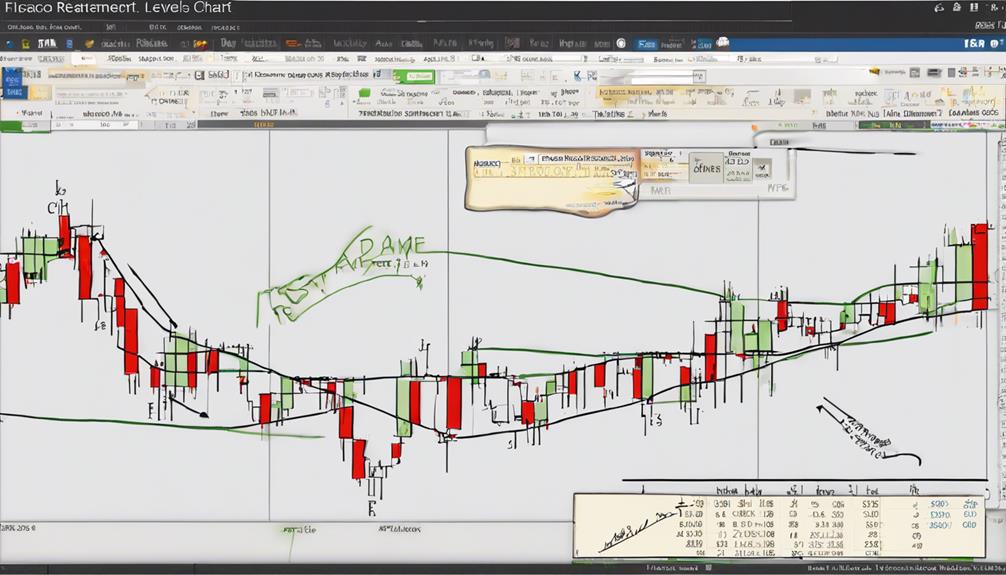
Fibonacci retracement levels play a crucial role in determining potential support and resistance areas within market corrections. Traders rely on these levels to gauge the extent of price retracements and to set profit targets and stop-loss orders effectively.
Understanding the significance of Fibonacci ratios can enhance traders' abilities to navigate price movements within Elliott Wave patterns.
Fib Levels Importance
How can traders leverage Fibonacci retracement levels to identify crucial support and resistance points in price movements?
Fibonacci retracement levels play a vital role in trading analysis, offering valuable insights into potential price movements. Here are five key points to consider:
- Fibonacci retracement levels act as significant support and resistance zones.
- Traders use these levels to anticipate potential reversal or continuation points in price trends.
- Common retracement levels such as 23.6%, 38.2%, 50%, 61.8%, and 78.6% are widely monitored.
- Fibonacci extensions beyond 100% can indicate possible price targets for future waves in Elliott Wave Theory.
- The 61.8% retracement level, known as the golden ratio, holds particular importance in identifying potential turning points in price action.
Retracement Strategy Tips
Utilizing Fibonacci retracement levels effectively can enhance a trader's ability to pinpoint strategic entry and exit points within the context of Elliott Wave analysis. These levels act as crucial support and resistance areas, indicating potential reversal points in a trend.
Traders commonly use key Fibonacci levels such as 23.6%, 38.2%, 50%, 61.8%, and 78.6% to identify significant price levels. While the 50% retracement level is not a Fibonacci number, it holds relevance in trading analysis.
Practicing Patience in Analysis
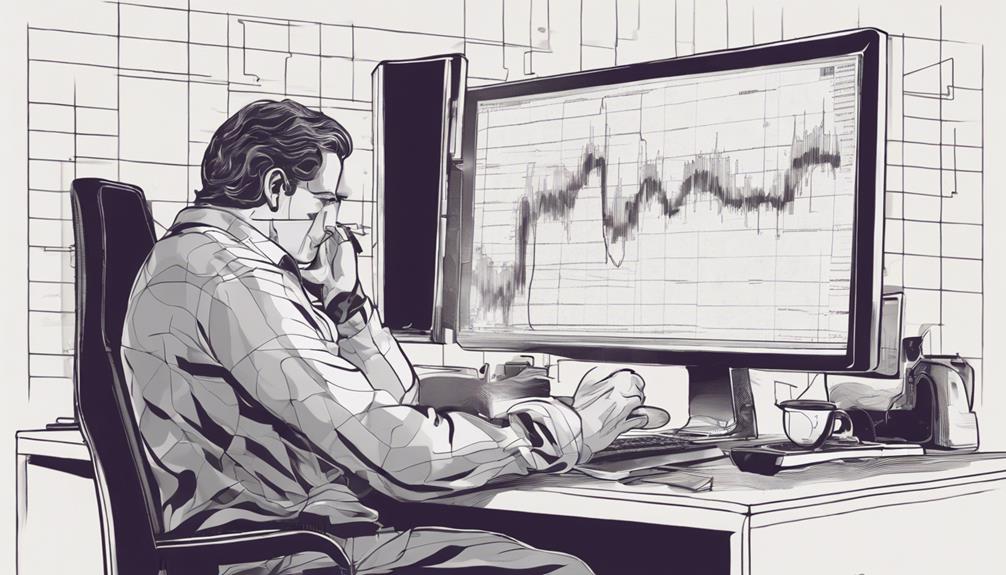
Exercising patience in Elliott Wave analysis is paramount for accurately identifying and confirming wave patterns. To master this aspect of analysis, traders should consider the following key points:
- Analyzing Multiple Time Frames: Examining various time frames aids in confirming wave counts and determining trend directions effectively.
- Waiting for Clear Wave Structures: Patience is essential to wait for distinct wave patterns to form before making trading decisions.
- Seeking Breakouts for Confirmation: Waiting for breakouts after a potential wave formation can provide more reliable signals for entering trades.
- Preventing Premature Trades: Patience prevents impulsive trades based on incomplete wave structures, leading to more informed decisions.
- Emphasizing Confirmation Signals: Understanding and waiting for confirmation signals before acting improves trading discipline and decision-making processes.
Validating Wave Counts
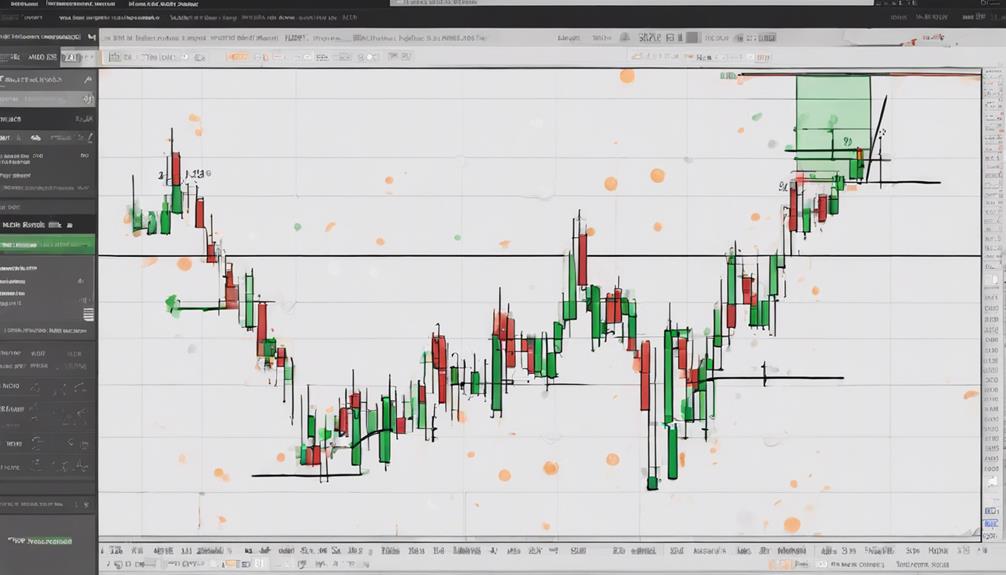
To ensure the accuracy of Elliott Wave Theory analysis, validating wave counts is crucial in confirming the adherence of each wave to the theory's rules and guidelines. Traders often rely on Fibonacci retracement levels to validate wave counts, as these levels can indicate potential reversal points and provide insights into the market's direction. It is essential for wave counts to follow the correct sequence of impulse and corrective waves to maintain accuracy in Elliott Wave analysis.
Additionally, incorporating technical indicators such as moving averages and RSI can further validate wave counts and confirm emerging market trends.
Regularly reviewing and adjusting wave counts based on market movements and new price data is paramount for accurate analysis. By staying vigilant and ensuring that wave counts align with the principles of Elliott Wave Theory, traders can enhance their ability to forecast market movements effectively.
Validating wave counts not only strengthens the overall analysis but also helps traders make informed decisions based on a solid foundation of wave principles and market dynamics.
Setting Realistic Targets

When setting realistic targets in trading with Elliott Wave Theory, it is crucial to consider historical price movements and key support/resistance levels for guidance. Analyzing Fibonacci levels can aid in determining potential price targets based on wave structures, enhancing the accuracy of predictions.
Goal-Setting for Success
In the realm of successful trading with Elliott Wave Theory, the establishment of realistic profit targets is a critical element that underpins strategic decision-making. When setting trading goals, traders should consider wave patterns and conduct thorough market analysis to define clear objectives. By establishing achievable profit targets, traders can effectively manage risk and maximize potential profits. Having specific price levels in mind not only aids in decision-making during trading but also helps align trading strategies with market conditions and trend dynamics.
Overall, realistic goal-setting plays a fundamental role in guiding traders towards making informed decisions and optimizing their trading performance.
- Define clear objectives based on wave patterns and market analysis.
- Establish achievable profit targets to manage risk effectively.
- Use specific price levels to aid decision-making during trading.
- Align trading strategies with market conditions and trend dynamics.
- Optimize trading performance through realistic goal-setting.
Achieving Profit Targets
Strategically setting realistic profit targets is a key component in achieving success when trading with Elliott Wave Theory. Profit targets are commonly set using Fibonacci extensions, such as 100%, 161.8%, or 261.8% of the previous wave's length.
By utilizing Elliott Wave theory, traders can pinpoint potential reversal zones where price movements are likely to align with profit targets. It is crucial to adjust these targets based on the wave count and structure to accurately reflect expected market movements.
To manage risk effectively, consider taking partial profits at key Fibonacci levels and implementing trailing stop-loss orders. These orders help secure profits during market volatility while still allowing for potential further gains, enhancing overall trading outcomes.
Managing Risk With Stop Loss

Implementing a well-defined stop loss strategy is crucial for effectively managing risk when trading with Elliott Wave Theory. Traders rely on stop loss orders to limit potential losses and protect profits, especially in volatile markets.
To ensure effective risk management, adjusting stop loss levels based on market conditions and price movements is essential. Proper placement of stop loss orders is critical; they should not be too tight, triggering prematurely, or too wide, resulting in excessive losses.
Monitoring Market Sentiment
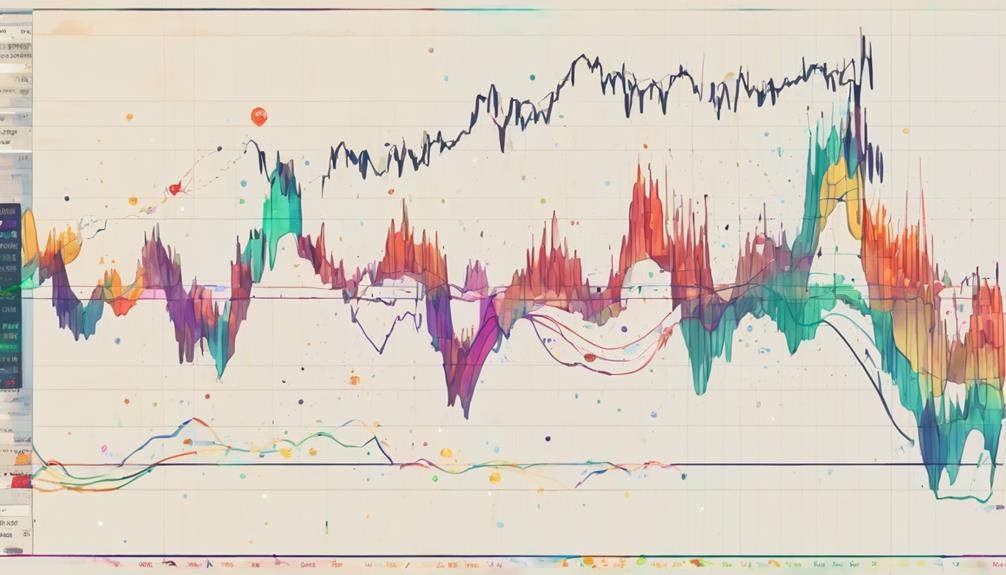
Monitoring market sentiment is crucial for traders as it provides valuable insights into investor emotions and market trends. By utilizing various indicators like the Fear and Greed Index, social media platforms, and the Put/Call Ratio, traders can gauge market sentiment and potential shifts in crowd psychology.
Understanding sentiment indicators can offer behavioral finance insights and help traders navigate market fear, uncertainty, and the impact of collective investor decisions on trading strategies.
Sentiment Indicators Importance
Market sentiment indicators play a crucial role in evaluating investors' feelings and attitudes toward an asset, aiding traders in determining the prevailing market sentiment.
- Sentiment indicators gauge market participants' emotions and attitudes towards an asset.
- They help traders assess the overall sentiment in the market, whether it's bullish, bearish, or neutral.
- Common sentiment indicators include the Fear and Greed Index, put/call ratios, and surveys of market sentiment.
- Monitoring sentiment indicators can provide contrarian trading opportunities when the market sentiment reaches extreme levels.
- Understanding market sentiment can help traders anticipate potential price reversals or trend continuations.
Behavioral Finance Insights
Analyzing investor behavior and emotions provides valuable insights into the underlying psychological drivers of market movements, aiding traders in anticipating potential shifts in market direction. In the realm of behavioral finance, understanding how emotions like fear and greed influence decision-making is crucial.
By monitoring market sentiment, traders can grasp the prevailing mood in the market, which can signal potential trend reversals. This insight into investor behavior allows traders to capitalize on market inefficiencies and make informed trading decisions.
Integrating behavioral finance insights with Elliott Wave Theory offers a comprehensive approach to interpreting market dynamics, enhancing traders' ability to navigate uncertainty and volatility effectively. By combining these analytical tools, traders can gain a deeper understanding of market sentiment and improve their trading strategies.
Crowd Psychology Impact
Understanding the impact of crowd psychology on market sentiment is crucial for traders navigating the dynamics of financial markets. Market sentiment plays a significant role in influencing price movements and shaping trading strategies.
Here are five key points to consider regarding crowd psychology's impact on trading:
- Monitoring market sentiment helps traders gauge the collective mood and behavior of market participants.
- Crowd psychology influences decision-making processes based on prevailing sentiment indicators.
- Traders react to news, events, and technical analysis signals, reflecting crowd psychology in price movements.
- Utilizing tools like the Fear and Greed Index can provide insights into market sentiment extremes.
- Anticipating market reversals, trends, and trading opportunities becomes easier with a deep understanding of crowd psychology.
Adapting to Market Conditions

Remaining flexible and adaptable to shifts in market conditions is crucial for effectively applying Elliott Wave Theory in trading strategies. By staying attuned to market conditions, traders can identify key support and resistance levels to make informed decisions.
Utilizing multiple time frames for analysis is essential to capturing the nuances of market dynamics and trends, allowing for a more comprehensive view of price action. Additionally, implementing robust risk management strategies is vital to safeguarding capital during volatile market shifts.
Traders must continuously review and reassess their trading plans to ensure alignment with evolving market conditions and capitalize on opportunities as they arise. Adapting to changing market conditions requires a proactive approach, where traders are responsive to shifts in sentiment and price action.
Seeking Mentorship and Community

To deepen comprehension and enhance trading proficiency in utilizing Elliott Wave Theory, seeking mentorship and engaging with a trading community can provide invaluable guidance and support. Mentorship from experienced traders can offer clarity on complex wave patterns, leading to improved trading decisions. Engaging with a mentor accelerates learning and fosters mastery of Elliott Wave principles. Joining a trading community allows for feedback on wave counts and analysis, enhancing the accuracy of Elliott Wave predictions. Collaborating with other traders provides diverse perspectives on market trends and wave interpretations.
- Mentorship from experienced traders clarifies complex wave patterns.
- Engaging with a mentor accelerates learning and mastery.
- Joining a trading community offers feedback on wave counts and analysis.
- Community collaboration provides diverse perspectives on market trends.
- Feedback from the trading community enhances accuracy in Elliott Wave predictions.
What are the key differences in trading with Elliott Wave Theory for commodities compared to general trading?
When trading with Elliott Wave Theory for commodities, it’s crucial to understand the unique market dynamics and price movements specific to each commodity. Applying the best commodity trading tips within the framework of Elliott Wave Theory can help traders anticipate and capitalize on market trends more effectively.
Frequently Asked Questions
What Is the Best Indicator to Use With Elliott Wave?
When utilizing Elliott Wave Theory, the Relative Strength Index (RSI) emerges as a valuable tool. RSI aids in pinpointing market extremes, while its divergence can validate trend shifts in conjunction with Elliott Wave analysis, making it a favored indicator for traders.
How Do You Trade Using Elliot Wave Theory?
Trading with Elliott Wave Theory involves identifying market trends through wave patterns and Fibonacci ratios. Utilize impulse and corrective waves for strategic entries, waiting for confirmation signals. Understand corrective waves within larger trends for successful trading applications.
Is Elliott Wave Good for Trading?
Elliott Wave Theory can be beneficial for trading when used alongside other technical analysis tools. It provides a structured approach to market analysis, aiding in anticipating price movements by identifying wave patterns and market psychology.
What Are the 3 Rules of Elliott Wave?
Elliott Wave Theory's three cardinal rules serve as guiding lights for traders: Wave 2 cannot breach the start of Wave 1; Wave 3 must exceed Wave 1; and Wave 4 cannot encroach upon Wave 1's territory.
Conclusion
In conclusion, as the saying goes, 'knowledge is power.' By mastering the principles of Elliott Wave Theory and implementing these top tips for trading, traders can gain a deeper understanding of market dynamics and make more informed trading decisions.
It is essential to continuously hone analytical skills, manage risks effectively, and stay adaptable to changing market conditions. By following these guidelines, traders can navigate the markets with confidence and success.
